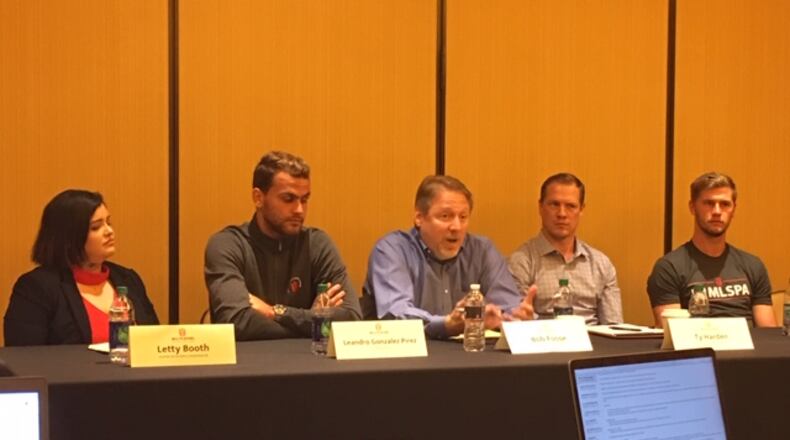MLS players are prepared to strike should negotiations for a new collective bargaining agreement with the league and club owners not reach a satisfactory conclusion. The current CBA expires in January 2020.
“A strike (for 2020 season) is never the goal,” MLSPA executive director Bob Foose said Wednesday. “It’s not our goal. If we each come to the table and work hard to find common ground, I’m very confident that we can reach an agreement that will benefit both the player pool and the league. That’s my hope and all the players’ hope that will happen.
“If it doesn’t happen, the player pool will make a decision to determine as to whether or not they will play based upon the terms on the table. That will be a real decision. It’s certainly not a fait accompli that the players will accept whatever is there. That’s not the way it’s going to happen.”
The MLS Players Association leadership and players Brad Guzan and Leandro Gonzalez Pirez of the Atlanta United and Walker Zimmerman met with reporters Wednesday ahead of the All-Star game in Orlando to discuss what they would like in the next CBA. The MLSPA have been discussing their wants for the past 18 months through thousands of phone calls, face-to-face meetings and other correspondences.
“If MLS wants to be a league of choice, it has to be a league that players actually will choose to play in,” Foose said. “Players are going to choose to play in leagues that look and act and feel like the best leagues in the world. That’s what we are after.”
MLS Commissioner Don Garber said he is convinced that the two sides will reach an agreement that makes sense for everyone.
Foose broke down the players’ demands into:
- Wanting the league to be more transparent with greater accountability, particularly for clubs that haven't invested as much as others. "It's time to let the poor performers deal with the consequences much more than they've had to in the past," according to Foose.
- The ability for players to have more say into where they live, work and income potential, including greater bonuses for performances.
- An openness to how teams can construct their rosters rather than through a centrally dictated mechanism.
- Continued investment from owners for things such as more charter flights for games.
Foose said the league and club owners seem willing to listen to expanding the possibility of increasing the number of charter flights. The current CBA allows for four charter segments per team per season. Foose said the players aren’t asking for luxury flights that feature massages in king-sized beds. It’s about moving the players as quickly as possible from one point to another within a congested schedule. He said charter flights are the equivalent in importance as training facilities and described them as a “fundamental building block” to improving the league’s quality.
Foose declined to say how much charter flights could cost because there a variety of factors that go into the expense, including the sizes of the planes, the number of people, the time of the year, and fuel costs. He did say the increased cost would be a “big number … a significant investment.”
Foose said MLS has the fewest number of training days for players than any league in the world. Charter flights would add at least 10 training days, according to Foose.
Guzan said the charter flights are necessary to improve the product on the field.
“It’s huge,” Guzan said. “It’s huge for your preparation going into a game, and it’s massive for recovery afterward and ultimately prepare for your next game. The product on the field comes from preparation, at training and your training facility.”
“Because of the country we live in and the travel requirements, charter flights are massive.”
Gonzalez Pirez, who played for several clubs in Argentina, estimated 80 percent of the flights in that league are chartered. He said the longest flight in Argentina was three hours.
“It’s the biggest sport in the world,” Gonzalez Pirez. “We need to take that seriously.”
Garber didn’t sound as positive on Wednesday about the possibility of chartering flights for road games, saying the two groups will need to discuss how to allocate a finite pool of money.
“I’d love to be in a situation where our players can travel charter to every game,” Garber said. “I get the fact that we are going across multiple time zones and our country is very large and that has an impact on our players. But it’s all about how we allocate our resources and where do we and our players prioritize our available spending.”
As for roster construction, Foose said he senses from ongoing discussions that an agreement can be reached on changes to the Targeted Allocation Money and General Allocation Money mechanisms that MLS uses for player acquisition and compensation. TAM and GAM are unique to MLS. They allow clubs to spend more to pay certain players. Foose said the players don’t like TAM because it excludes, and therefore demoralizes, certain players on the lower end of the roster who can’t receive those funds as part of compensation.
“It’s not doing anything but holding us back,” Foose said when comparing MLS now with how it was years ago.
Foose said there is no hard deadline for a possible work stoppage. The league’s 2020 schedule will start in late February. He said the MLSPA deadline would be a few days around that. Foose said the MLSPA has a strike fund and that it will spend every penny should it be needed to survive a protracted work stoppage.
Guzan said the players have been preparing for months for a possible stoppage. Those conversations include the players discussing living arrangements, work visas, savings, training sites, etc.
“We understand that if it’s going to come to that, we are ready for that,” Guzan said. “We hope that in good faith we are both able to come to the table and find common ground and continue to grow this sport and grow this league in a positive direction.”
About the Author
Keep Reading
The Latest
Featured


